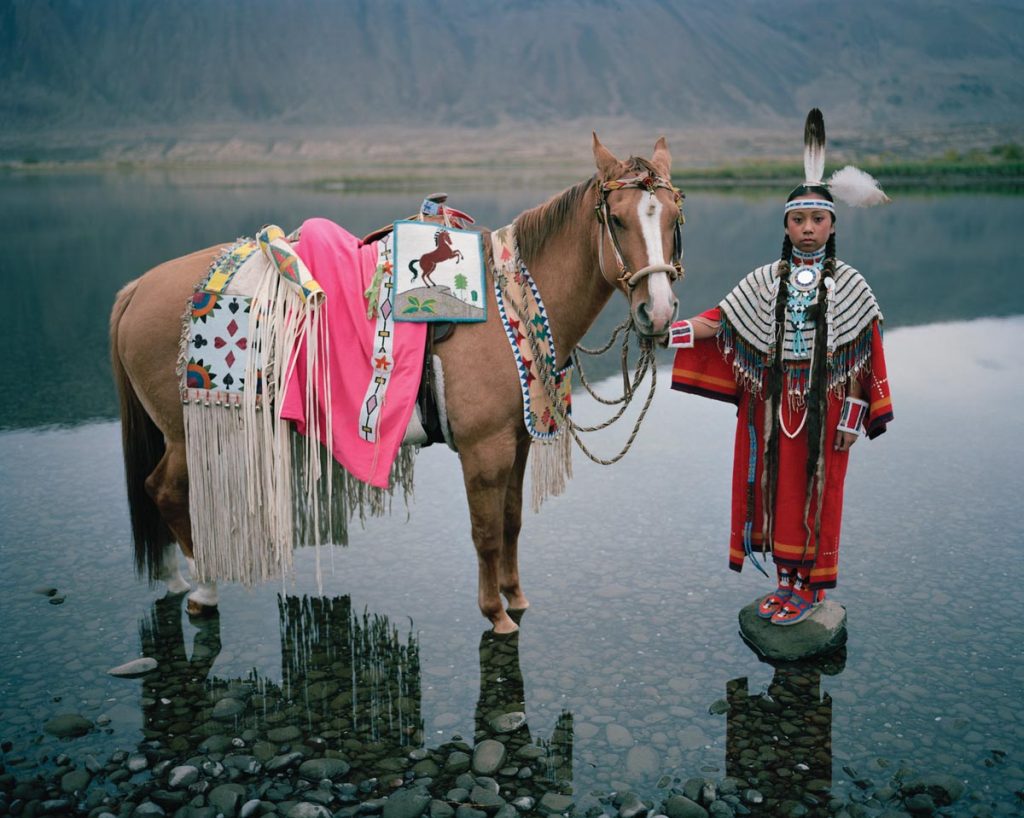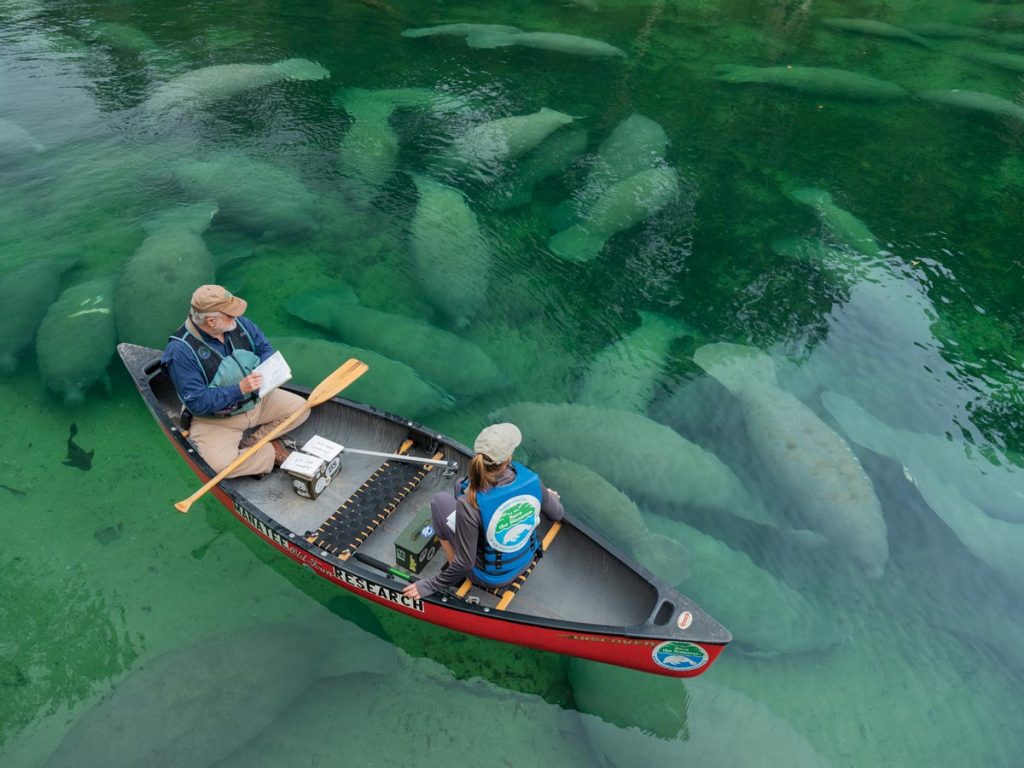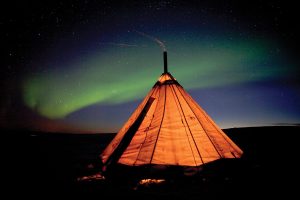
Erika Larsen reaches high onto a shelf behind her desk and retrieves a Pentax K1000 camera that she bought when she was 15. Even at that young age, she believed that photography would be her means of connecting with the world around her.
“My dad worked for NASA on the Hubble Space Telescope, [and] I remember him bringing home some of the early images that were coming back from Saturn,” says Larsen. “There was that moment of realization that you can hold the planets in your hand. I thought not only is photography bringing something that’s very far away close, it’s also reminding me that I’m a part of everything.”

Since that first Pentax, Larsen has used dozens of cameras and traveled all over the world documenting the intersection of humans and the natural world. National publications including Time, Field & Stream, and National Geographic have commissioned her for pictorials, and her work has been included in exhibitions at the Smithsonian National Portrait Gallery, the National Geographic Society, and the Fotografiska Museum in Stockholm, Sweden. She is currently a National Geographic Explorer and Photographer, a designation that National Geographic reserves for “exceptional individuals in their fields who receive funding and support from the society to illuminate and protect our world through their work in science, exploration, education, and storytelling.”
Larsen is renowned for her unique photographic expressions. In an interview with Larsen for the National Press Photographers Association, Jim Colton, former photo editor for Newsweek, wrote that “a photograph can also speak volumes with a whisper. The stoic beauty of a quiet moment can pierce the heart. Few have managed to do that as well as Erika Larsen. Her work, in a word, is enchanting, simple in structure, thoughtful in composition, and always conveying her vision with a quiet elegance.”

A Boynton Beach resident, Larsen is now focusing her camera closer to home. This past year, she had a feature story in National Geographic about the Florida manatee. “[We chronicled] what was going on with the manatee and the environmental impacts of what is happening with manatee habitats, seagrass loss on the East Coast, and seagrass restoration on the West Coast in places like Crystal River, and how large organizations are working with the manatee situation.”
The story emanated from another project, a Florida-based film that she is cowriting and codirecting. “We look at what it means to be enchanted and how we can find a deeper connection with our daily lives and the environment … and how that pushes us to think about our own existence in connection with the world around us,” says Larsen, who has been working on the film for two years. As research, she is currently enrolled in a yearlong program at the University of Amsterdam’s Centre for the History of Hermetic Philosophy and Related Currents, focusing on academic research and teaching in the field of esotericism. “I am looking at the theological currents and how we relate to existence in order to deepen our character development for our film.”

This in-depth research is indicative of Larsen’s dedication to her craft. As a high-school student in Maryland, she enrolled in weekend classes at a local community college and began studying photography. “I remember talking to my teacher and saying, ‘I want to do this as a career,’” she recalls. The teacher encouraged her to apply to the Rochester Institute of Technology (RIT) in Rochester, New York, home to Eastman Kodak. Larsen submitted her only college application to RIT and was accepted. She earned a BFA in photography in 1997, followed by an MFA in animation and film and computer graphics in 1999.
After graduation, she moved to New York City and spent a year assisting photographers in all genres while building her own portfolio. She started showing her work to publications like Time, Newsweek, Fortune, and The New York Times. In 2001, she landed one of her first freelance jobs at Time magazine. “Time hired me to do themes around everyday people dealing with difficult life moments,” she explains. “My work reflected these more quiet, intimate moments. I was young and in my own process of how do you process other people’s emotions? How do you process spending time with a family dealing with a terminal illness?”

Looking for a respite, Larsen focused on a new project in her off time. “I began to photograph hunting. I started working for Field & Stream magazine. I was looking at how hunting ties into the ancestral and cultural connections in Canada and the United States.”
In 2007, she moved to the Scandinavian Arctic and lived with Sámi reindeer herders to better understand their culture and relationship to their ancestral roots and the Arctic landscape. While there, she learned the North Sámi indigenous language, which currently has between 12,000 and 15,000 speakers. “I was able to create this extended story about the Sámi reindeer herder connection to their ancestral past and how they bridge that into a modern economic society,” she says. The work comprises her first monograph, a book entitled Sámi, Walking with Reindeer, published in 2013.

The Sámi project caught the attention of the team at National Geographic, for which she now regularly creates provocative images that tell compelling stories of man and nature. Some of her most noted pictorials include the first National Geographic single-topic issue, published in 2016 and titled Yellowstone: The Battle for the American West.
Her work was also showcased in an issue called Women: A Century of Change, which came out in 2019. “We produced an entire issue of National Geographic done entirely by women, photographed by women, edited by women, written by women, about women, and I was the main portrait photographer on that,” says Larsen. For the project, she photographed 21 women around the world, including the prime minister of New Zealand; Oprah Winfrey; Emma Gonzalez, an activist and survivor of the Marjory Stoneman Douglas High School shooting; and Sylvia Earle, a marine biologist who grew up in Florida.
Larsen’s collaborators note both the aesthetic integrity and the sense of connection and understanding she brings to her assignments. “I have always been struck by the tenderness Erika shows in her work and how deep she goes into her subjects,” says Sarah Leen, director of photography emerita for National Geographic Partners and the founder and editor of Visual Thinking Collective. “Her sensitivity is very special and people can feel that.”
“What sets Erika apart is her unwavering dedication to grasping the essence of the stories she’s entrusted to convey,” says Kaya Berne, a photo editor who has worked with Larsen on pictorials for National Geographic and Time. “She consistently invests extra time in researching the subject matter and thinking creatively about ways to authentically [portray] her subjects. Erika approaches her assignments as if they were her own stories, demonstrating profound empathy and a willingness to gain a new perspective.”

Larsen is excited to continue to challenge her visual storytelling capabilities with her Florida film project, which she describes as a “fictionalized interpretation of real-life events in Florida. The plot weaves together multiple timelines to reveal stories about Florida’s cultural, environmental, and geopolitical history and the spirit of enterprise that leads characters from the depths of primordial swamps to dreams of our cosmic origins among the stars.”
She hopes the film will give viewers an opportunity to learn about the human story in relation to time and existence. “Photography is this way for us to understand who we are.”
Featured image: Larsen in Montana, photographed by Andriana Mereuta.







